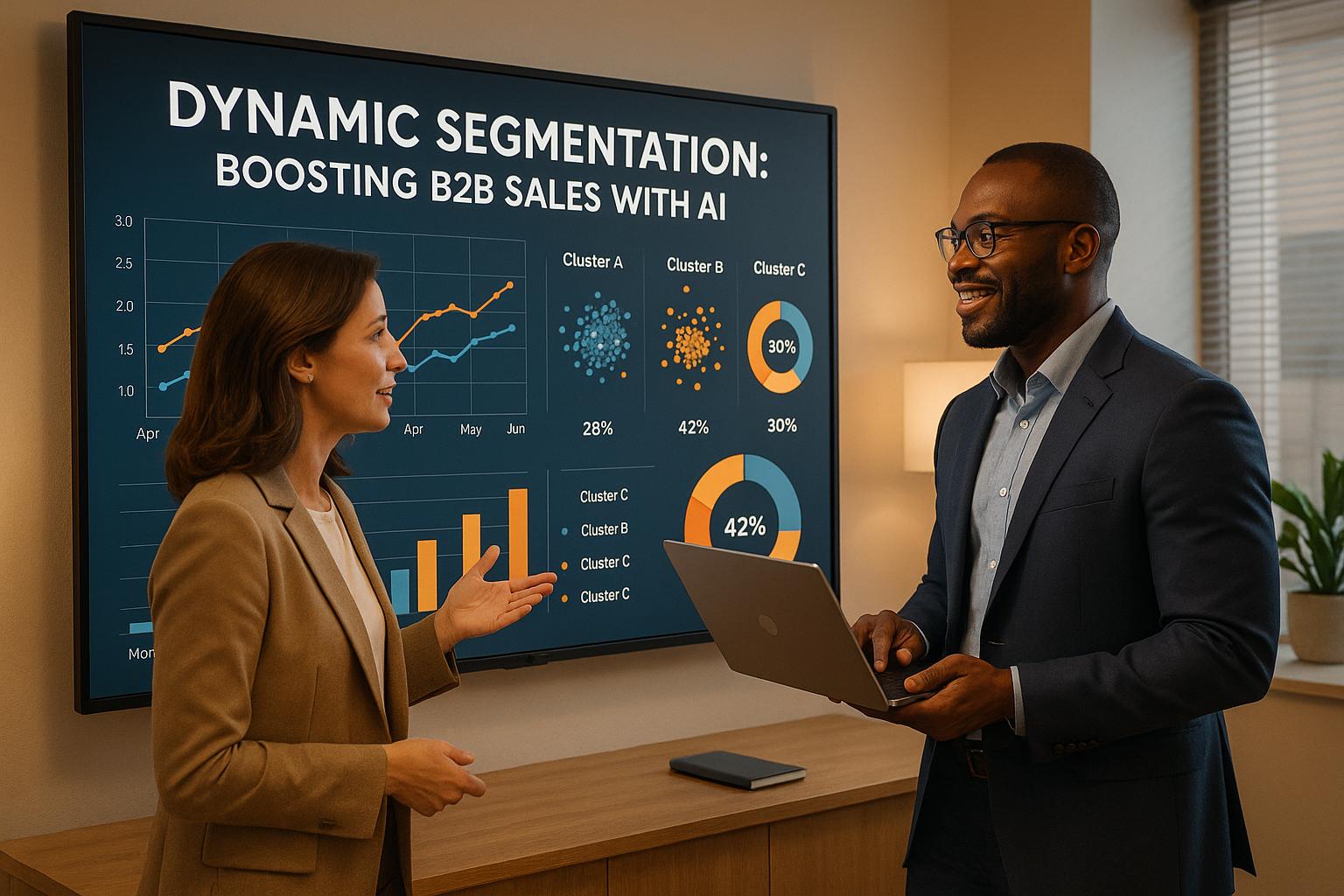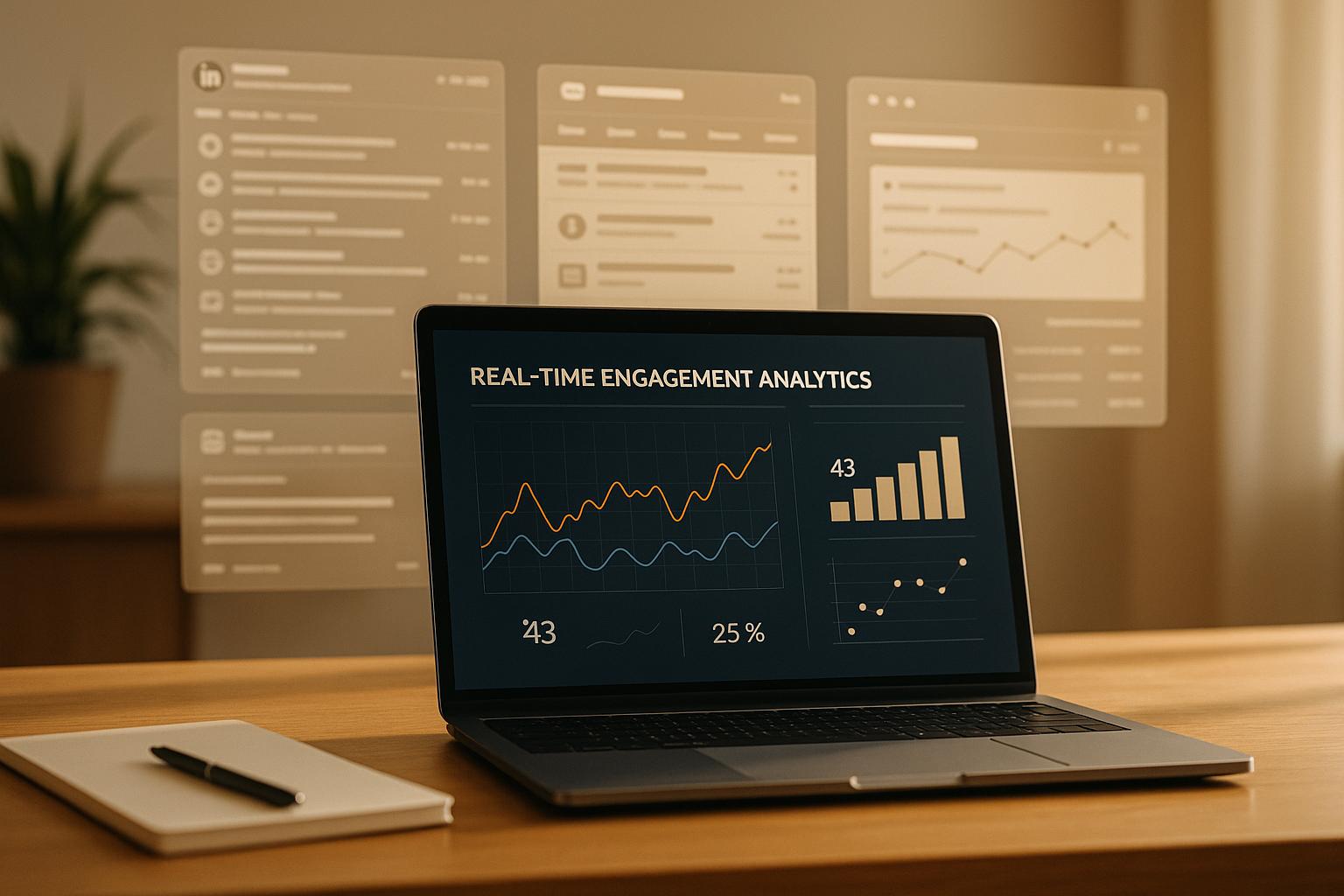
.avif)
Julien Gadea
Julien Gadea specializes in AI prospecting solutions for business growth. Empowering businesses to connect with their audience with SalesMind AI tools that automate your sales funnel, starting from lead generation.
Dynamic segmentation is reshaping how B2B sales teams target and engage buyers. Instead of relying on static categories like company size or industry, this AI-powered approach creates real-time, behavior-based buyer groups. Here's how it works:
- Machine Learning: Continuously analyzes buyer actions (e.g., website visits, email opens) to update segments in real time.
- Natural Language Processing (NLP): Interprets buyer conversations (e.g., emails, chats) to understand their needs and intent.
- Predictive Analytics: Anticipates future buyer behavior, such as purchase timelines and deal sizes.
This approach helps sales teams focus on high-potential leads, personalize outreach, and shorten sales cycles. For instance, platforms like SalesMind AI use dynamic segmentation to monitor buyer activity, adjust messaging, and optimize LinkedIn outreach. By integrating with existing CRMs, businesses can implement these tools while ensuring compliance with U.S. data privacy laws.
Dynamic segmentation is not a one-time setup - it requires regular updates and monitoring. Sales teams that adopt it can expect better lead targeting, faster conversions, and improved pipeline management.
Customer Segmentation With A.I. | Finding Your Unknown Unknowns
The AI Tech in Dynamic Segmentation
Dynamic segmentation uses three main AI tech tools that change how businesses talk to buyers. These tools put buyers into groups in ways old methods just couldn't do. Let's dig into how each tool is key.
Machine Learning for Right-Now Data Study
At the core of dynamic segmentation is machine learning. This tool works with huge amounts of buyer data as it gets updated. Old systems checked data piece by piece, but machine learning looks at it all the time, always watching how buyers act.
These tools keep an eye on key things - like site visits, emails opened, content download, and social media moves - as they happen. When buyer habits shift, machine learning quickly changes their group.
The big win of machine learning is finding patterns. For example, if a buyer often downloads white papers or goes a lot to pricing pages fast, the system may mark them as "ready to buy" and move them to the right group.
Also, the system learns better over time. Each sale, lost deal, or chat sharpens its skill, leading to better groups and sales results. This right-now data study also sets the base for deep insights, which come out through NLP.
Natural Language Processing for Buyer Thoughts
Natural language processing (NLP) looks past numbers, jumping into the words buyers use to show their thoughts and likes. By checking texts from emails, chat notes, social media posts, and calls, NLP finds out what buyers are really thinking and feeling.
For example, if a buyer’s emails or chats talk of hurry or budget talks, they might be seen as a "hot lead." NLP also spots special topics - like data safety, saving money, or learning needs - that click with each buyer. This helps sales teams make messages that fit each buyer's main needs.
By pulling ideas from many chat ways, NLP gives a full view of each buyer's likes, letting teams make more aimed and useful groups.
Predictive Analytics for Sales Guesses
The third part of this setup is predictive analytics, which uses old data to guess what buyers might do next. This tool lets sales teams spot buyers with high chance, predict when they'll decide, and guess their spending limit.
For instance, by looking at past deals, predictive analytics can show how long buyers in the same spot usually take to decide. This insight helps sales teams plan when to reach out, shape how they talk, and use resources better.
Also, by comparing new buyer moves with past cases, predictive analytics can guess possible deal sizes, letting teams focus on top chances.
When put together, these three AI tools - machine learning, NLP, and predictive analytics - give a full view of each buyer. Machine learning spots behavior trends, NLP reads thoughts and likes, and predictive analytics looks ahead to future moves. Together, they make dynamic segmentation much more strong and exact than just using any single tool.
How Smart Grouping Changes B2B Sales
Smart grouping with AI power is changing B2B sales by making lead aiming better, making what's coming next clear, and making more leads turn into sales. Let’s see how these new steps lead to more leads, better managed sales flow, and clear results.
More Leads and Higher Sales
Smart grouping shifts how we find and change leads. AI tools can spot who may buy soon, letting firms focus on those really into buying instead of trying to reach everyone. This way lets sales groups send right-on-point messages that deal with things like keeping data safe, cutting costs, or other big needs. Also, time is key - reaching out on things like LinkedIn, email, and phone works best when done at the right time.
Better Sales Flow Control
AI grouping also changes how sales flows are run. With better look into how deals move along, sales teams can put their work into leads that may buy soon, often making the sales time shorter and guesses more right. Predictive data shows which deals might close, making sure effort and money go to the right place. Plus, knowing more about what buyers do can show chances to sell more or other items, which makes deals bigger. This means less time on unlikely leads and more on ones that matter.
Sales Numbers: Before and After AI
The changes are clear in key sales numbers. Firms that use AI grouping see better lead sorting, more leads turning into sales, and truer flow checks - all while spending less on each lead. These better points often make deal sizes bigger and sales groups do more. The result? Shorter times to sell, more deals closed by each rep, and higher money made. As the AI keeps getting its grouping better, these upsides grow, making lead aiming and closing deals even better as time goes on.
sbb-itb-817c6a5
Dynamic Segmentation at Work
Dynamic segmentation is changing B2B sales by taking out guessing and using clear, data-based plans. By grouping prospects automatically, platforms help businesses - big or small - to grow personalized reach. SalesMind AI pushes this idea further, placing these rules right into its outreach tools.
Features of SalesMind AI's Dynamic Segmentation

SalesMind AI shapes LinkedIn outreach through dynamic segmentation. The platform keeps checking prospect behavior, how they engage, and their profile details to make live, changing groups. For example, if a prospect looks at a LinkedIn profile or touches certain content, the AI quickly shifts them and starts follow-up moves made for their activity.
The platform’s unified inbox is a key spot for managing outreach. Sales teams can see how different groups respond to different messages, as the system sees which ways work best for each prospect type. For instance, top bosses may like talks on big business goals, while tech managers might like more detailed, tech-heavy talks.
More than just simple demographics, SalesMind AI uses deep lead scoring to look into things like company growth, new funds, tech use, or new hires. Scores change as new info comes in, giving sales teams useful, timely insights into their prospects.
This live data mix boosts targeted messaging and helps grow sales. The platform changes follow-up plans based on group behavior: prospects with high intent get more, direct communications, while nurturing groups get educational content slower. The AI also makes messages personal by looking at industry news, company changes, and role-specific issues, making sure outreach meets each decision-maker's own top needs.
These tools have helped U.S. sales teams get better at outreach, making their work more exact and powerful.
U.S. Business Success Stories
Though specific stories from SalesMind AI aren’t shared, industry trends show that dynamic segmentation lifts engagement and outreach. By helping sales teams time and personalize their talks better, this method leads to quicker, more ready sales pipelines.
How to Implement Dynamic Segmentation
Rolling out dynamic segmentation effectively can lead to better lead conversion rates and smoother sales pipeline management. The key is to implement it step by step, ensuring it works seamlessly with your current systems.
Connecting AI with Current Sales Tools
Instead of diving in all at once, start by integrating your AI segmentation platform with your existing CRM. Focus on mapping essential customer fields like company size, industry, contact details, and behavioral data. Set up daily synchronizations - or, if you're working with fast-moving sales cycles, go for real-time updates.
To avoid hiccups, test the integration with a small sample size of 100–200 contacts. This lets you identify and fix any data mapping issues before scaling up to your full database.
Your sales team needs full visibility into how segments are created and updated. Tools like SalesMind AI provide a unified inbox where reps can see segment assignments alongside prospect interactions. This clarity helps them understand why a prospect belongs to a particular group and tailor their approach effectively.
Once the integration is live, keep a close eye on your segments to ensure they remain accurate and effective.
Monitoring and Updating Segmentation Models
AI-driven segmentation isn’t a "set it and forget it" process. It requires continuous monitoring to adapt to changing market conditions. During the first month, review segment performance weekly. Pay attention to metrics like email open rates, response rates, and meeting booking rates for each segment.
Accurate data is the backbone of dynamic segmentation. Set up alerts to flag incomplete profiles, outdated information, or unusual activity patterns that might indicate errors.
Adjust your segmentation criteria every quarter based on how prospects interact with your campaigns. For example, if companies that recently secured funding respond better to specific messaging, create a dedicated segment for them. Over time, the AI will learn from these updates and refine its patterns.
Also, track how prospects move between segments. This insight can help you design better nurturing strategies. Involve your sales team in reviewing these transitions for real-time feedback.
While optimizing performance, don’t overlook the importance of strict data privacy and compliance measures.
U.S. Compliance and Data Privacy Requirements
Adhering to U.S. data privacy regulations is crucial when implementing AI-driven segmentation.
Start by understanding the limits of your data collection practices. Your privacy policy should clearly outline how AI segmentation works and offer prospects the option to opt out.
Establish data retention policies that automatically delete old or inactive prospect data. Most B2B companies retain data for 2–3 years, but it’s important to confirm the specific requirements for your industry.
Secure your AI platform with robust authentication methods and role-based access controls. Document everything - segmentation logic, data points used, update schedules, and actions taken - for compliance audits.
Train your team on compliance protocols, including how to handle data deletion requests, manage data access, and share information responsibly. Additionally, review vendor agreements to ensure your AI provider meets all U.S. data protection standards.
A measured, methodical approach typically takes 4–6 weeks to go from initial setup to full deployment. Companies that follow this process often see better adoption and quicker results.
Key Takeaways
AI-powered dynamic segmentation is reshaping B2B sales by moving beyond static demographics to create real-time, behavior-based customer segments. This shift allows businesses to respond more effectively to customer needs in the moment.
With this approach, AI-driven segmentation enhances conversion rates and speeds up sales cycles. It identifies buying signals and intent patterns that traditional methods often overlook, giving sales teams a sharper edge in targeting the right prospects.
Technologies like machine learning, natural language processing, and predictive analytics continuously refine these segments, offering more accurate forecasts of conversion potential.
For businesses in the U.S., successful implementation hinges on adhering to data privacy regulations and compliance standards. To get the most out of dynamic segmentation, companies should focus on integrating it with their CRM systems, providing team training, and maintaining ongoing monitoring to ensure optimal performance.
One example of this in action is SalesMind AI. By combining dynamic segmentation with LinkedIn outreach, it enables personalized messaging at scale. Features like a unified inbox and advanced lead scoring further streamline the process, making outreach both efficient and effective.
These takeaways highlight the practical value of incorporating AI-driven segmentation into your sales strategy. To see lasting results, treat dynamic segmentation as a continuous process. Regular updates, monitoring, and maintaining high-quality data are key to keeping your sales pipeline running smoothly and effectively.
FAQs
What makes dynamic segmentation different from traditional methods in B2B sales?
Dynamic segmentation takes a modern approach by using real-time data to automatically refine customer segments based on specific rules. This method offers a more adaptable and responsive way to keep up with shifting customer behaviors.
In contrast to traditional segmentation - which depends on fixed, unchanging groupings - dynamic segmentation evolves constantly. This means businesses can achieve sharper targeting, tailor their outreach efforts, and boost sales performance, leading to stronger outcomes in B2B sales.
How can AI-powered dynamic segmentation benefit sales teams?
AI-driven dynamic segmentation empowers sales teams to work more efficiently by pinpointing the ideal prospects with unmatched accuracy. It automates the process of crafting personalized messages and managing outreach, enabling teams to connect with a larger pool of leads without the need to expand their workforce.
By analyzing and understanding the specific needs and preferences of potential customers, this approach consistently delivers high-quality leads. The result? Improved engagement, time saved, and a smoother sales process that lets teams concentrate on sealing deals and boosting growth.
How can companies comply with U.S. data privacy laws when using AI for segmentation?
To align with U.S. data privacy laws while leveraging AI for segmentation, businesses need to prioritize robust data security measures and maintain transparent data practices. This means protecting personal information, securing proper consent, and openly explaining how data will be utilized.
Staying updated on state-specific privacy laws is equally important, as several states have introduced comprehensive regulations. Companies should ensure their data collection and processing methods adhere to these rules, while also respecting consumer rights like accessing or deleting personal data.
Additionally, incorporating explainable AI systems can be a game-changer. These systems offer clear explanations of how AI-driven decisions are made, helping businesses build consumer trust and demonstrate their commitment to privacy compliance.




